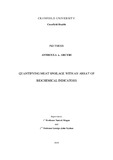JavaScript is disabled for your browser. Some features of this site may not work without it.
| dc.contributor.advisor | Magan, Naresh | |
| dc.contributor.advisor | Nychas, George-John E. | |
| dc.contributor.author | Argyri, Anthoula A. | |
| dc.date.accessioned | 2011-06-29T08:58:00Z | |
| dc.date.available | 2011-06-29T08:58:00Z | |
| dc.date.issued | 2010 | |
| dc.identifier.uri | http://dspace.lib.cranfield.ac.uk/handle/1826/5621 | |
| dc.description.abstract | Freshness and safety of muscle foods are generally considered as the most important parameters for the food industry. It is crucial to validate and establish new rapid methods for the accurate detection of microbial spoilage of meats. In the current thesis, the microbial association of meat was monitored in parallel with the chemical changes, pH measurements and sensory analysis. Several chemical analytical techniques were applied to explore their dynamics on quantifying spoilage indicators and evaluate the shelf life of meat products. The applied analytical methods used were Fourier transform infrared (FTIR) spectroscopy, Raman spectroscopy, image analysis, high performance liquid chromatography (HPLC) and gas chromatography/mass spectroscopy (GC/MS). The first component of the study was designed to evaluate the potential of FTIR spectroscopy as a rapid, reagent-less and non-destructive analytical technique in estimating the freshness and shelf life of beef. For this reason, minced beef samples survey from the Greek market), beef fillet samples stored aerobically (0, 5, 10, 15 and 20ºC) and minced beef samples stored aerobically, under modified atmosphere packaging (MAP) and active packaging (0, 5, 10, and 15ºC), were analysed with FTIR. The statistical analysis from the survey revealed that the impact of the market type, the packaging type, the day and the season of purchase had a significant effect on the microbial association of mince. Furthermore, the Principal Components Analysis (PCA) and Factorial Discriminant Analysis (FDA), applied to the FTIR spectral data, showed discrimination of the samples based on freshness, packaging type, the day and season of purchase. The validated overall classification accuracies VCA) were 61.7% for the freshness, 79.2% for the packaging 80.5% for the season and 61.7% for the day of purchase. The shelf life of beef fillets and minced beef was evaluated and correlated with FTIR spectral data. This analysis revealed discrimination of the samples regarding their freshness (VCA 81.6% for the fillets, 76.34% for the mince), their storage temperature (VCA 55.3% and 88.1% for the fillets and mince, respectively) and the packaging type (VCA 92.5% for the mince). Moreover, estimations of the different microbial populations using Partial Least Squares Regression (PLS-R) were demonstrated (e.g. Total viable counts-TVC: RMSE 1.34 for the beef fillets and 0.72 for the mince). Cont/d. | en_UK |
| dc.language.iso | en | en_UK |
| dc.publisher | Cranfield University | en_UK |
| dc.title | Quantifying meat spoilage with an array of biochemical indicators | en_UK |
| dc.type | Thesis or dissertation | en_UK |
| dc.type.qualificationlevel | Doctoral | en_UK |
| dc.type.qualificationname | PhD | en_UK |
